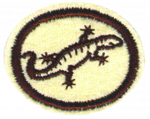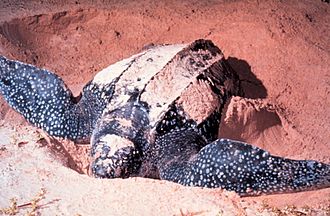AY Honors/Reptiles/Answer Key/es
| Reptiles | ||
|---|---|---|
| Asociación General
|
Destreza: 1 Año de introducción: 1937 |
|
Requisitos
|
La especialidad de Reptiles es un componente de la Maestría Zoología. |
| Conexión Logros para la Investidura: Esta especialidad está relacionada con los requisitos de Logros para la Investidura para AMIGO Estudio de la naturaleza que requiere (como una de dos opciones) el mantener un reptil como está escrito en el requisito 6b de esta especialidad. Esta especialidad es una elección popular para la especialidad de la categoría de Estudio de la naturaleza de nivel de destreza 1 requerido para los AMIGOS. |
1
Los reptiles son animales de sangre fría. Son de piel gruesa. La mayoría tienen escamas y se reproducen por desove, pero varios dan a luz a crías vivas. La falta de una etapa larval distingue los reptiles de los anfibios.
2
Los reptiles también incluyen los cocodrilos y los lagarts, entonces si se pueden encontrar esos animales en su área, deben ser nombrados.
eNature.com es un buen recursos para esto (sólo disponible en inglés). Se puede buscar la vida silvestre por código postal y también da información de cada animal.
3
Algunas áreas no tienen reptiles venenosos, entonces se puede interpretar «área geofráfica» como el continente entero.
Norteamérica
| Reptil | Distribución | Ubicación de los colmillos |
|---|---|---|
| Monstruo de Gila | Suroeste de los E.E.U.U., norte de México | Mandíbula inferior |
| Lagarto Enchaquirado | Guatemala, México | Mandíbula inferior |
| Cabeza de cobre | Sur del estado de Massachusetts hasta Florida hacia el oeste a Texas hacia el norte a Iowa |
Mandíbula superior, al frente de la boca |
| Boca de algodón | Este de los E.E.U.U. | Mandíbula superior, al frente de la boca |
| Serpiente de coral | Sureste de los E.E.U.U. | Mandíbula superior, al frente de la boca |
| Serpiente de cascabel | Varias especies, desde el sur de Canadá hasta Sudamérica | Mandíbula superior |
Sudamérica
Asia
Europa
África
Australasia
4
5
El tratamiento de una mordedura de serpiente no venenosa es esencialmente el mismo que el tratamiento para heridas punzantes. Limpie la herida, cúbrela con un vendaje estéril y busque atención médica.
6
6a
Historia de vida de un gecko leopardo
Geckos leopardo alcanzan la madurez sexual a los 10 a 14 meses de edad. El sexo Gecko Leopardo puede determinarse una vez que el animal alcanza una longitud adulta de más de 12 cm.
Geckos leopardo reproducen desde marzo hasta septiembre, aunque la temporada puede comenzar en enero y terminar hasta octubre. Treinta días después, la hembra pone uno o dos huevos con una cáscara coriácea. Dos huevos se ponen cada dos semanas cada mes durante todo el resto de la temporada y varía de cada gecko según la edad, con las hembras de más edad que pone menos huevos poco a poco con cada año. Los huevos tienen que ser incubados.
Al igual que muchos otros reptiles ovíparos, el sexo de los geckos leopardo son determinados por la temperatura de incubación. Los huevos que son incubados a 26° C resultarán en una mayoría de hembras, mientras huevos incubados a 29-30° C resultarán en una proporción más incluso de ambos sexos y los huevos incubados a 31-32° C en las primeras cuatro semanas resultarán en más machos. Las hembras nacidos de estos huevos son generalmente más agresivos que las otras hembras y tienden a alcanzar la madurez sexual más tarde. Una temperatura de incubación más bajo que 25° C o más alto que 36° C causará deformidades y generalmente la muerte de los neonatos incubados a estas temperaturas.
Los geckos nacen 6 a 12 semanas después, dependiendo de la temperatura. El gecko rompe la superficie del huevo y empuja su cabeza fuera, permaneciendo en esta posición de 2 a 4 horas adaptándose a la respiración pulmonar y la obtención de oxígeno a partir de las membranas de huevo, así como la absorción de la yema desde el interior del huevo.
Gecko verde (Naultinus gemmeus)
Junto con el gecko con el hocico áspero de Nueva Caledonia (Rhacodactylus trachyrhynchus) todos los geckos de Nueva Zelanda dan a luz a crías vivas. Los huevos eclosionan en el oviducto y se produce un nacimiento. Cada camada consta de dos bebés. Después de tres años, o dependiendo de la temperatura y la disponibilidad de alimentos haciendo que causa que crezcan a un buen tamaño, llegan a la madurez sexual. El apareamiento toma lugar en septiembre u octubre, y el parto en mayo o junio.
Life History of the Garter Snake
Before they mate, garter snakes go into brumation, which is a state similar to hibernation. They stop eating for about two weeks beforehand to clear their stomach of any food that would rot there otherwise. Garter snakes begin mating as soon as they emerge from brumation. In chillier parts of their range, male common garter snakes awaken from brumation first, giving themselves enough time to prepare to mate with females when they finally appear. After mating, a female leaves the den/mating area to find food and a place to give birth. Female garter snakes are able to store the male's sperm for years before fertilization. The young are incubated in the lower abdomen, at about the midpoint of the length of the mother's body. Garter snakes are viviparous, meaning they give birth to live young. Gestation is two to three months in most species. As few as 3 or as many as 50 snakes are born in a single litter. The babies are independent upon birth.
Life History of the Leatherback Turtle
Like all sea turtles, leatherback turtles start their lives as hatchlings bursting out from the sands of their nesting beaches. Right after they hatch, the baby turtles are already in danger of predation. Many are eaten by birds, crustaceans or other reptiles before they reach the water. Once they reach the ocean they are generally not seen again until maturity. Very few turtles survive this mysterious period to become adults. It is known that juvenile leatherbacks spend a majority of their particular life stage in more tropical waters than the adults.
Adults are prone to long-distance bouts of migration. Migration in leatherback turtles occurs between the cold waters in which mature leatherbacks cruise in to feed on the abundant masses of jellyfish that occur in those waters, to the tropical and subtropical beaches in the regions where they were hatched from. In the Atlantic, individual females tagged in French Guiana off the coast of South America have been recaptured on the other side of the ocean in Morocco and Spain.
Mating between leatherback turtles take place at sea. Leatherback males never leave the water once they enter it unlike females which crawl onto land to nest.
While the other species of sea turtles almost-always return to the same beaches they hatched from, female leatherback turtles have been found to be capable of switching to another beach within the same general region of their "home" beach. Chosen nesting beaches are comprised of soft sand since their shells and plastrons (the turtle's underside) are softer and easily damaged by hard rocks. Nesting beaches also have shallower approach angles from the sea. This is a source of vulnerability for the turtles because such beaches are easily eroded. Females excavate a nest above the high-tide line with their flippers. One female may lay as many as nine clutches in one breeding season. About nine days pass between nesting events. The average clutch size of this particular species is around 110 eggs per nest, 85% of which are viable. The female carefully back-fills the nest after, disguising it from predators with a scattering of sand.
The eggs hatch in about sixty to seventy days. As with other reptiles, the ambient temperature of the nest determines the sex of the hatchlings. After nightfall, the hatchlings dig their way to the surface and make their way to the sea.
Comparisons
| Reptile | Eyes | Ears | Teeth | Heart | Lungs | Limbs | Tails | Scales |
|---|---|---|---|---|---|---|---|---|
| Lizards | movable eyelids |
external | sharp, tricuspid (3-points) |
3 chambers | 2 full lungs |
4 legs | breaks off |
do not grow, but sheds |
| Snakes | transparent eyelids, permanently closed |
internal | grooved or hollow |
3 chambers | left lung smaller or absent |
none | does not detach |
do not grow, but sheds |
| Turtles | have eyelids | external | no teeth, have beaks |
3 chambers | 2 full lungs |
4 legs | tucks into shell |
grow some form shell |
| Crocodiles | one transparent, one opaque |
have "earlids" | sharp, designed to tear |
4 chambers | 2 full lungs |
4 legs | powerful | grow |
6b
Most pet shops carry turtles, lizards, and snakes, as well as the equipment needed to care for them (including terrariums). Pet store staff are generally very knowledgeable about caring for reptiles and will be able to answer your questions. They may also have brochures on reptile care.
Remember that pet reptiles (and amphibians, birds, and small mammals) should never be released into the wild. The main reason for this is that they may not be indigenous to the area and may cause severe ecological problems to the native populations. Further, they can easily spread disease to the native creatures. Even if none of these things come to pass, domestic pets are ill-equipped to survive in the wild, having not lived there in their past.
Therefore, in deciding whether or not to keep a pet reptile to meet this requirement, take this into consideration. If you misjudge your commitment to your reptile pet, you are responsible to find it another home. Under no circumstances should you release a pet into the wild.
7
Eve tempted by the serpent in the garden of Eden (Genesis 3)
Moses and Aaron's staffs becoming snakes (Exodus 4 & 7)
People who were bit by snakes could look at bronze snake on pole to live (Numbers 21)
Paul was bitten by a viper, which he shook off into the fire. The people thought he was a god since he didn't die. (Acts 28)
Referencias
- Categoría: Tiene imagen de insignia
- Adventist Youth Honors Answer Book/Honors/es
- Adventist Youth Honors Answer Book/es
- Adventist Youth Honors Answer Book/Skill Level 1/es
- Categoría: Libro de respuestas de especialidades JA/Especialidades introducidas en 1937
- Adventist Youth Honors Answer Book/General Conference/es
- Adventist Youth Honors Answer Book/Nature/es
- Adventist Youth Honors Answer Book/Nature/Primary/es
- Adventist Youth Honors Answer Book/Stage 100/es
- Adventist Youth Honors Answer Book/Zoology Master Award/Domestic/es
- Adventist Youth Honors Answer Book/IAConnection/es





